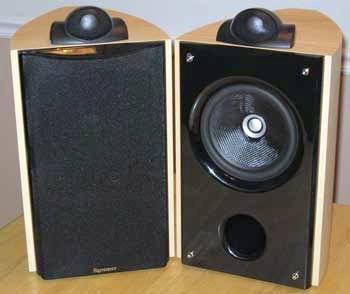
Though the speakers appear to be yet more of the single-driver trash passed off as HT gear, they're actually 2-ways - that bump in the middle of the driver is actually a tweeter, mounted within the center of the woofer. While unorthodox, this "coaxial" design is nothing new - Tannoy has been using this configuration in terrific studio monitors for decades.
Aside from the unusual configuration of the drivers, the coaxial unit is itself something of an oddball. Unlike many cheap imitations therof, the woofer is real carbon fiber, and the tweeter is a real silk dome - no mylar junk or textured paper. The box has a rounded back - almost unheard of for units actually made out of MDF instead of cheap plastic - and is of remarkable quality. Even the finish is pretty good.
If one digs beneath the surface, the source of the speakers' unusual quality is evident: They're actually just a stripped-down version of Radiient's Europa surround-sound satellites.
Radiient came out of nowhere in something of a Cinderella story, except that Cinderella was not staffed with some of the best audio engineers of the buisness. Notables include the guy who invented the HDMI 1.3 standard, and from what I've heard, many people jumped ship from Energy - a now-defunct brand known in its own day for producing high-quality, reasonably priced speakers.
Though originally regarded as an excellent value at the $200 original pricetag, the Europas are availible today for just $100 a pair - and with free shipping, no less! Of course, many ask: Why send away for a pair of speakers when I can get some essentially the same at my local Best Buy for $30 less?
That $30 pays for a plethora of improvements - some visible, some not. In order to deal with irregularities on the high-end response of the coaxial driver, the Europa features a supertweeter - the funny bump on the top - to handle the ultra-high frequencies. In addition, partially as a result of the supertweeter, the crossover is of higher quality and a better design.
Unless you're ordering the B-2111s used or getting them on sale, I'd strongly reccomend the Europas. I've only heard the B2111s myself, but for the extra $30, you get quite a bit for your money!







